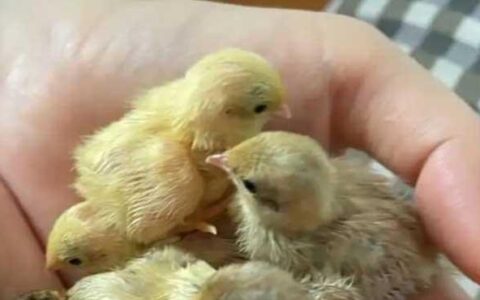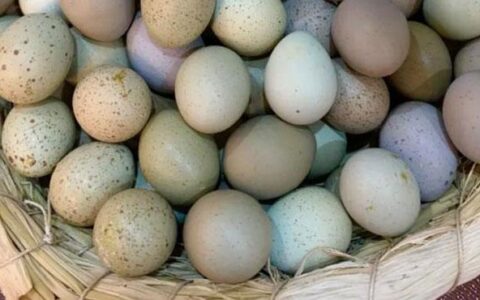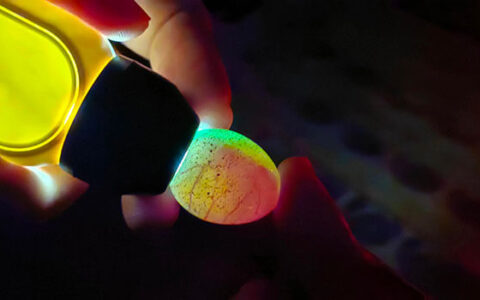2300 Words Introduce The Whole Process Of Hatching Rutin Chickens
After more than six years of exploration, Chinese Wang Zepu has completed the development of the whole industrial chain of rutin chicken and mastered the complete set of technology of rutin chicken.
After more than six years of exploration, Chinese Wang Zepu has completed the development of the whole industrial chain of rutin chicken and mastered the complete set of technology of rutin chicken. The hatching technology of rutin chicken is introduced as follows.
Unfertilized eggs
The part of the breeding egg that is usually called the yolk is just a cell, i.e., the female germ cell or egg. The yolk is overwhelmingly nutrient-rich, with the nucleus and most of the cytoplasm concentrated as a small, irregular white dot floating above the yolk and below the yolk membrane, as shown by the arrow in the figure. This kind of egg is incubated but cannot develop and is called an unfertilized egg.
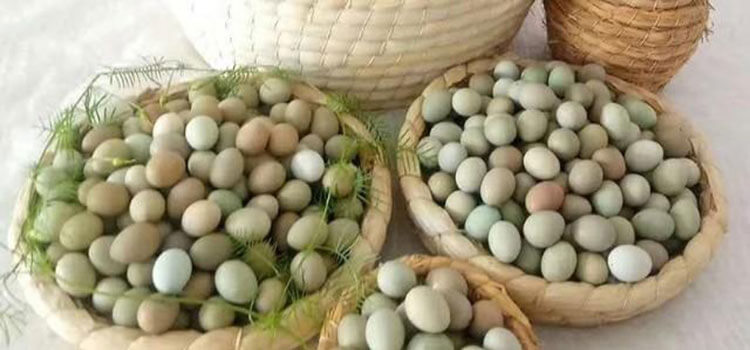
Fertilized egg
The egg is fertilized when it meets the sperm in the funnel of the oviduct. The fertilized egg divides continuously during its stay in the mother’s body. It divides into a mass of cells by the time the rutin egg is produced outside the body. From the front, the blastocyst looks like a disc covering the yolk’s surface, with a bright area in the center and a dark area at the edge, usually called the embryonic disc.
Day 1
After 24 hours of incubation, the blastodisc becomes more prominent and thicker, with both the bright and dark areas increasing.
Day 2
The embryonic disc has doubled in size and is surrounded by red vessels in cherry or oval shape. These are the marginal vessels of the yolk sac circulation of the embryo —- marginal sinus. A varicose hyaline body is in the center of the embryonic disc —- seed, and a small pulsating red dot, the primitive heart, is visible in the hyaline body.
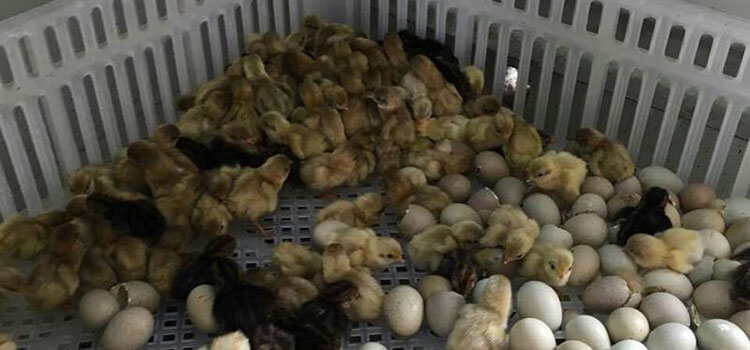
Day 3
From the first day of hatching, water in the proteins moves through the semi-permeable yolk membrane into the yolk, causing a significant increase in the water content of the yolk, and the new incoming water does not fuse with the yolk fluid whole cents. Still, it is mainly present in the embryonic region. The embryo and the extended yolk sac blood vessels resemble mosquitoes. The mosquito-like blood vessels can be seen in the white eggs through visualization, commonly known as “mosquito beads.”
Day 4
The yolk volume continues to increase, the color becomes lighter, and the yolk sac blood vessels surround nearly 1/3 of the yolk, which can exchange gas with the outside world due to the pressure of liquefaction and expansion of the yolk, causing the yolk sac blood vessels to adhere to the inner shell membrane. The yolk does not turn quickly when the rutin egg is illuminated. The embryo and yolk sac vessels resemble spiders, commonly known as “little spiders.” The urinary bladder is a tiny blister, and the eyes begin to deposit melanin. The embryo is enclosed in a transparent blister (amniotic membrane) filled with amniotic fluid, the source is curved, and the eyes are heavily melanized. The yolk sac surrounds 1/2 of the yolk, and the eye’s shadow can be seen when the rutin chicken egg is photographed, commonly called “single bead” or “black eye.” The urinary bladder can be seen with the naked eye and is about 6 mm in diameter.
Day 5
The urinary bladder proliferates about 4 times in one day, and the vascular system of the urinary bladder develops rapidly, covering the amnion and part of the yolk, but finer than the yolk vasculature; the yolk vasculature is distributed over 2/3 of the yolk area. The embryo body has the appearance of wings and legs, and the eyes have more melanin. Two small round clusters of head and carapace are visible in the egg, commonly called “double beads.” The yolk volume reaches its maximum and will be gradually reduced. Although the yolk sac also increases in size, 1/4 of the yolk is uncovered; the urinary bladder is about twice as large as on day 6; the fetus has the characteristics of a bird. The head and eyes take up a large proportion, and the front and hind limbs are clearly differentiated. The transparency of the fetus begins to decrease, and the embryo is half-submerged and half-floating, lying in the amniotic fluid.
Day 6
The urinary bladder doubled in size compared to day 7 and almost surrounded the yolk sac. Day 4 to day 8 is the first stage of urinary bladder development when the embryo transforms from yolk sac breathing to urinary bladder breathing. The fetal shape tends to be well-developed. The upper beak is white, the breaking teeth are clearly visible, and the thoracic and abdominal cavities are not yet closed. The heart, liver, and stomach are exposed outside the body cavity. Amniotic fluid and allantoic fluid increase rapidly. The urinary bladder develops rapidly along the endometrium toward the lower end, enclosing the fetus and yolk and enclosing part of the egg, parting white. Fetal skin transparency decreases, and neatly arranged dots, or feather primordia, appear on the skin surface. The thoracic and abdominal cavities have been closed, and the heart, liver, stomach, and other organs have been encapsulated into the body cavity.
Day 7
The urinary bladder develops rapidly on the back of the embryo toward the lower end, gradually enclosing the protein. When the 10th day of incubation is over, the urinary bladder is not yet closed. However, it slowly encircles toward the small end. The original base of the feathers of the highwayman’s skin is spread throughout the body, and the tips of the wing and leg feathers are already slightly exposed. The fetus is positioned close to the air chamber.
Day 8
As the urinary bladder completely encloses the yolk, embryo body, and protein, the vessels of the urinary bladder have anastomosed at the small end, which is the 10th day and a half after hatching, and the rutin chicken egg test calls this phenomenon “closing.” From day 8 to day 11 is the second stage of allantoic development. Closing the urinary bladder is of great significance, as it is the only way to ensure that the fetus swallows protein.
Day 9
The picture shows a small hole at the protein end of the urinary bladder that has not yet closed. The seems too slow for a 9-day-old embryo. Due to individual differences, this is not uncommon; the source has short feathers all over with claws already keratinized. The protein was pale yellowish-brown and sticky, and the amniotic plasma tract was formed.
Day 10
The amniotic tracts are elongated channels that transport protein to the amniotic plasma cavity. The sticky protein keeps entering the will amniotic hole, like squeezing toothpaste, due to the envelopment and contraction of the urinary bladder and mixes with the amniotic fluid. This protein-laden amniotic fluid, called protein amniotic fluid, and the fetus begins to swallow large amounts of protein amniotic fluid. During the tenth to the thirteenth day of incubation, the fetus takes in nutrients from the yolk sac and the digestive tract by swallowing protein amniotic fluid. Due to the balance of various amino acids in the protein, the fetus’s weight increases rapidly, from about 2 grams on day 10 to about 5 grams on day 14.
Day 11
The allantoic vessels are fully developed and adhere to the shell membrane, expelling carbon dioxide and water vapor and taking in oxygen through the inner shell membrane and eggshell; the allantoic fluid increases and is mainly concentrated around the amnion, and the metabolism is vigorous, and the fetus gains weight rapidly. The blood vessels of the urinary bladder rupture efficiently when dissecting the embryonic egg. The fetus swallows a lot of protein, which provides nutrition for weight gain and feather growth, and the neck feathers reach 10 mm in length. Experience has been passed on that around this date is the hair-raising period, and the incubation temperature should be stable to ensure that the fetus swallows and digests protein properly. The protein enclosed by the urinary bladder decreases. When the embryonic egg is illuminated, the shiny part of the small end shrinks, and the black shadow part of the embryo body and yolk increases. The feathers of the fetus are increasing, with the neck feathers reaching 12 mm in length, the feathers of all parts of the body growing neatly, and the tibia and toe scales beginning to form.
Day 12
The protein surrounding the urinary bladder into slight reduction, and the urinary bladder fluid color becomes mixed. There is a small amount of urate accumulation due to swallowing white, embryonic metabolites increase, and excretion of urate stored in the urinary bladder. The fetus continues to increase in weight, feathers lengthen and become abundant, and the length of the neck feathers up to 15 mm. This is the cooked whole embryo, stripped of its urinary bladder. By 13 days of incubation, protein delivery to the amniotic cavity is complete, and the fetus is still surrounded by amniotic fluid of protein. The fresh monogastric of the fetus is shown in the small picture. The lactic clot can be seen in the stomach, and originally a clear protein amniotic fluid was swallowed into the stomach. And turned into a lactic chunk by the action of gastric acid and digestive enzymes. The fetus increases in weight due to the intake of full-valent protein from egg white and yolk. And the development of shape and feathers does not differ much from that of the fledgling. From day 11 to day 13 of hatching is the third stage of allantoic development, when the allantoic sacs close up, and the fetus can fully ingest the proteins. When the embryonic egg is examined, it is a black shadow of the fetus and yolk, commonly referred to as “closed.”
Day 13
The remaining protein amniotic fluid has been swallowed, the allantoic juice is reduced, the air chamber is enlarged, the allantoic sac is thickened and contracted, and the whole embryo is easily detached from the eggshell membrane. Urate deposits can be seen on three sides. Due to better protein utilization, fetal feathers cover the surface of the rutin chicken body like satin. After that, there is only one source of nutrition for the fetus —- yolk. The air chamber continues to expand, the urinary bladder and amniotic fluid continue to decrease, and the deposition of fastidious urate increases. And the urinary bladder vessels are bright red, indicating that the urinary bladder still functions as a respiratory organ. On the 14th day of incubation, spread wings were visible in the air chamber, and the beaks of a few chicks penetrated the inner shell membrane and reached the air chamber. The chicks can be heard a chirp. The chick’s nutrition depends entirely on the yolk. And some of the yolks have been included in the abdominal cavity. Once the chick’s beak enters the air into the air chamber, the respiration of the lungs begins. And at this time, the respiration of the chick’s urinary bladder and lungs coexist and gradually transition from the former to the latter. Respiration is high, and metabolic heat production is significantly increased, usually on this day ‘fallen plate.’
Day 14
The 15th day of incubation is the most critical. Chicks are guarded against sac respiration to lung respiration, the remaining part of the yolk is included in the abdominal cavity, and the chicks build up strength and prepare to emerge from the shell. A lot of shell pecking should be done at the beginning of the 16th day. The chick’s beak has already penetrated the air chamber, then the shell membrane is cut with the shell-breaking teeth, and then the brim is pushed outward to break the eggshell. The shell is pecked, and the chick can breathe directly from the outside. The allantoic membrane begins to wither at this time, but blood vessels are still at work. Most of the yolk is included in the abdominal cavity, and only a tiny part is exposed outside the abdomen. After breaking the shell and a few hours of development, the chick continues to move its head, continuously destroying the shell membrane and forming a ring-shaped gap in the chicken egg.
Day 15
The eggshell is pecked through, and the chick can breathe directly from the outside, at which point the allantoic membrane begins to wither, but there are still blood vessels at work. Most of the yolk is included in the abdominal cavity, and only a small portion is exposed outside the abdomen. After the shell is broken, and after several hours of development, the chick continues to move its head, continuously destroying the shell membrane and forming a ring-shaped gap in the egg. The shell is pecked through, and the chick can breathe directly from the outside, at which point the allantoic membrane begins to wither, but there are still blood vessels at work. Most of the yolk is included in the abdominal cavity, and only a small portion is exposed outside the abdomen. After breaking the shell and several hours of development, the chick continues to move its head, constantly destroying the shell membrane and forming a ring-shaped gap in the egg. On the late 15th day, chicks have already broken their shells. Many of them emerge in the first half of Athe 16th day. From shell pecking to emergence is an indispensable part of embryonic development and an essential physiological process. The chicks strengthen they are respiratory and circulatory. Locomotor systems during emergence. And promote the absorption of yolk and the contraction of the umbilicus.
Chick emergence: Chicks that have just broken out of their shells are wet with amniotic fluid and are weak in action. Their feathers are dry and puffy in the excellent environment of the emergence apparatus. They move actively and chirp powerfully and can then be moved out of the emergence apparatus. The fertilization rate of good breeding eggs is above %, and the hatching rate of fertilized eggs is also above 93%.
Notice: Internet users spontaneously contributed the article content, and the article views only represent the author himself. This site only provides storage services, does not have ownership, and bears relevant legal liabilities. If you find plagiarism, infringement, or illegal content, please contact the administrator to delete it.

